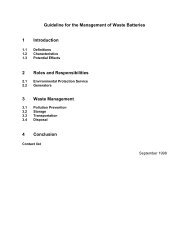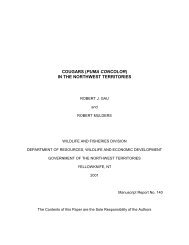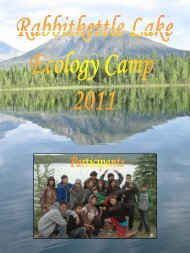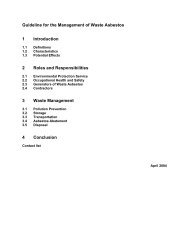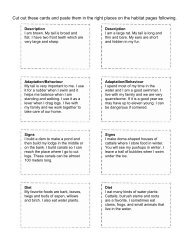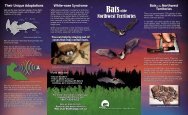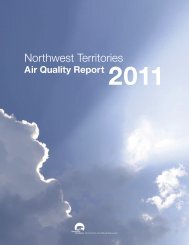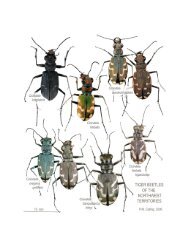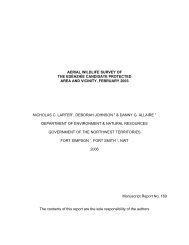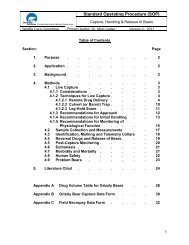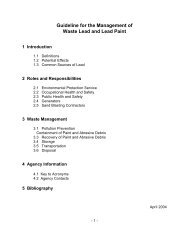Dragonflies of the Northwest Territories - Environment and Natural ...
Dragonflies of the Northwest Territories - Environment and Natural ...
Dragonflies of the Northwest Territories - Environment and Natural ...
Create successful ePaper yourself
Turn your PDF publications into a flip-book with our unique Google optimized e-Paper software.
ABSTRACT:Thirty-five species <strong>of</strong> Odonata are givenstatus ranks in <strong>the</strong> <strong>Northwest</strong> <strong>Territories</strong>based on number <strong>of</strong> occurrences <strong>and</strong>distributional area within <strong>the</strong> territory. Ninespecies are ranked as S2, may be at risk,including Aeshna subarctica, Lestescongener, Nehalennia irene, Ophiogomphuscolubrinus, Somatochlora albicincta,Somatochlora forcipata, Somatochlorafranklini, Somatochlora sahlbergii <strong>and</strong>Somatochlora septentrionalis. Many <strong>of</strong> <strong>the</strong>seare widespread <strong>and</strong> on <strong>the</strong> edge <strong>of</strong> <strong>the</strong>irrange in <strong>the</strong> <strong>Northwest</strong> <strong>Territories</strong>. The mostrestricted species overall in North Americais <strong>the</strong> Paleaectic - East BeringianSomatochlora sahlbergi. Ophiogomphuscolubrinus appears rare <strong>and</strong> local in <strong>the</strong>western part <strong>of</strong> its range. Nineteen speciesare ranked as S3, sensitive <strong>and</strong> 7 are rankedas S4, secure. The ranking is based on adatabase <strong>of</strong> 1040 records each defined asunique combination <strong>of</strong> date, location <strong>and</strong>collector. Rejected taxa <strong>and</strong> possibleadditions are outlined. Regions requiringfur<strong>the</strong>r survey are noted. Information oncollecting <strong>and</strong> inventory is provided.Distribution maps for <strong>the</strong> species in <strong>the</strong><strong>Northwest</strong> <strong>Territories</strong> are included.ACKNOWLEDGEMENTSHelp with many aspects <strong>of</strong> this work wasprovided by both Dr. Suzanne Carrière,Ecosystem Management Biologist, Wildlife<strong>and</strong> Fisheries, Dept. <strong>of</strong> Resources, Wildlife<strong>and</strong> Economic Development , Government<strong>of</strong> <strong>the</strong> <strong>Northwest</strong> <strong>Territories</strong> <strong>and</strong> Dr. LisaTwolan, Scientific Project Officer, GeneralStatus <strong>of</strong> Species in Canada, CanadianWildlife Service , Ottawa. Information onoccurrences was provided by Dr. RexKenner, Dr. Donna Giberson, Dr. NickDonnelly <strong>and</strong> Dr. Robert Cannings (somedetails provided below). Generalinformation on contacts <strong>and</strong> locations <strong>of</strong>collections provided by Dr. Cannings wasvery useful.METHODSThe dragonflies (ORDER - ODONATA) in<strong>the</strong> broad <strong>and</strong> frequently used sense include<strong>the</strong> suborder ANISOPTERA, <strong>the</strong> dragonflies<strong>and</strong> <strong>the</strong> suborder ZYGOPTERA, <strong>the</strong>damselflies. Both <strong>of</strong> <strong>the</strong>se suborders arecovered here.The general status ranking for dragonflies <strong>of</strong>NWT is part <strong>of</strong> an existing plan foradditional groups to be covered in <strong>the</strong> reporton general status due in 2005 (Carrière <strong>and</strong>Lange 2002).Ranks are generally assigned using <strong>the</strong>procedures manual <strong>and</strong> using threecategories <strong>of</strong> information: size, trend <strong>and</strong>threat in tables (Carrière <strong>and</strong> Lange 2002,pp. 6-14) <strong>and</strong> applying guidelines (Carrière<strong>and</strong> Lange 2002, pp. 16-17). The sizeinformation includes population size,number <strong>of</strong> occurrences, <strong>and</strong> distribution, thislatter being a percentage <strong>of</strong> <strong>the</strong> territoryoccupied. The trend information includes aconsideration <strong>of</strong> trends in both population<strong>and</strong> distribution. Threat includes both threatto population <strong>and</strong> threat to habitat. Speciesare assigned a rank corresponding to <strong>the</strong>most serious risk category <strong>of</strong> any indicator.In <strong>the</strong> case <strong>of</strong> dragonflies <strong>the</strong>re is currentlyno specific information on threat, trend <strong>and</strong>population size. Never<strong>the</strong>less specimens inseveral institutional collections have been3
<strong>and</strong> verified by two o<strong>the</strong>r acknowledgedOdonata experts leaving less than 5%lacking expert verification. A few records inthis 5% were dubious <strong>and</strong> were rejected (seebelow for an explanation).HISTORYThe earliest publication that ga<strong>the</strong>redtoge<strong>the</strong>r <strong>the</strong> widely scattered Odonatarecords for nor<strong>the</strong>rn Canada was that <strong>of</strong>Walker (1943) entitled “<strong>the</strong> subarcticOdonata <strong>of</strong> North America.” Although dateswere given <strong>the</strong>y did not include <strong>the</strong> year.There are a number <strong>of</strong> very early reports <strong>of</strong>Odonata from <strong>the</strong> <strong>Northwest</strong> <strong>Territories</strong>.Coenagrion resolutum <strong>and</strong> Somatochlorafranklini were reported from Fort Resolutionin 1875 by Selys, <strong>the</strong> former based on aspecimen in <strong>the</strong> Selys collection in Brussels(Walker 1925). Fort Resolution is <strong>the</strong> typelocality for both <strong>of</strong> <strong>the</strong>se species. In 1871Selys reported Somatcochloraseptentrionalis from Fort Simpson <strong>and</strong>Somatochlora hudsonica from FortResolution. In his North American synopsispublished in 1875, Hagen reported Aeshnaeremita, Aeshna juncea, Cordulia shurtleffi,Somatochlora franklini, Somatochloraforcipata <strong>and</strong> Leucorrhinia hudsonica fromFort Resolution.Most <strong>of</strong> <strong>the</strong> material from <strong>the</strong> <strong>Northwest</strong><strong>Territories</strong> in collections was obtainedduring <strong>the</strong> fisheries surveys <strong>of</strong> Great SlaveLake <strong>and</strong> during <strong>the</strong> Nor<strong>the</strong>rn Insect Survey,both <strong>of</strong> which occurred in <strong>the</strong> middle 20 thcentury. The major collector was J. R.Vockeroth, Research Scientist withAgriculture <strong>and</strong> Agri-Food Canada. Adetailed history <strong>of</strong> <strong>the</strong> survey <strong>of</strong> Odonata <strong>of</strong><strong>the</strong> <strong>Northwest</strong> <strong>Territories</strong> will appearelsewhere.RANKING RESULTSThirty-five species <strong>of</strong> Odonata wereassigned status ranks in <strong>the</strong> <strong>Northwest</strong><strong>Territories</strong> based on number <strong>of</strong> occurrences<strong>and</strong> distributional area within <strong>the</strong> territory(Appendices 1 <strong>and</strong> 2). Nine species areranked as S2, may be at risk, includingAeshna subarctica, Lestes congener,Nehalennia irene, Ophiogomphuscolubrinus, Somatochlora albicincta,Somatochlora forcipata, Somatochlorafranklini, Somatochlora sahlbergii <strong>and</strong>Somatochlora septentrionalis. Many <strong>of</strong> <strong>the</strong>seare widespread <strong>and</strong> on <strong>the</strong> edge <strong>of</strong> <strong>the</strong>irrange in <strong>the</strong> <strong>Northwest</strong> <strong>Territories</strong>. The mostrestricted species overall in North Americais <strong>the</strong> Paleaectic - East BeringianSomatochlora sahlbergi. Ophiogomphuscolubrinus appears rare <strong>and</strong> local in <strong>the</strong>western part <strong>of</strong> its range. Nineteen speciesare ranked as S3, sensitive <strong>and</strong> 7 are rankedas S4, secure.REJECTED TAXALeucorrhinia glacialis is listed from NivenLake near Yellowknife in <strong>the</strong> Royal BritishColumbia Museum database. The specimenwas collected by C. Shank on 2 July 1997.The specimen was not available forverification <strong>and</strong> is rejected as a probablemisidentification.Enallagma exsulans is listed from Inuvik,<strong>Northwest</strong> <strong>Territories</strong>, in <strong>the</strong> Royal BritishColumbia Museum database. The specimenwas collected on 18 Aug. 1985 by S.Laycock. It is rejected as a probable5
specimens are fragile <strong>and</strong> are not packedtightly. The glassine envelopes can beobtained from stores supplying stampcollector materials, or from biology supplycompanies (see below). The stores supplyingstamp <strong>and</strong> coin collector materials may alsocarry h<strong>and</strong> lenses (a little more powerful <strong>and</strong>useful for identification than a simplemagnifying glass).For more information on collecting methodssee www.afn.org/~iori <strong>and</strong> use links formore.Suppliers <strong>of</strong> dragonfly envelopes, nets,etc.American Biological Supply Co., 2405 N.W.66th Court, Gainsville, Florida 32653-1633.Phone: 352-377-3299; Fax: 352-375-AMBI.Full line supplier <strong>of</strong> fineentomological/biological eqwuipment forover 30 years.BioQuip Products, 17803 La Salle Avenue,Gardena, California 90248-3602. Phone:310-324-0620; Fax: 310-324-7931.Entomological & botanical equipment,books, s<strong>of</strong>tware.International Odonata Research Institute(IORI) - Odonata envelopes, books. I.O.R.I.,c/o Division <strong>of</strong> Plant Industry, P.O. Box147100, Gainsville, Florida 32614-7100Phone: 352-375-5903. Email: iori@afn.orgCollector's Code <strong>of</strong> EthicsA great deal <strong>of</strong> valuable information can beobtained from reliable sight records.Collecting a lot <strong>of</strong> specimens is thusgenerally unnecessary. To <strong>the</strong> extent that itis necessary, it should be justified. Nevercollect a rare or restricted species unless it isrelatively common at a site. Never collecton private l<strong>and</strong> without l<strong>and</strong>ownerpermission <strong>and</strong> remember that it is onlypossible to collect in parks with a specialpermit that may be given to researchersfollowing consideration <strong>of</strong> a researchproposal. Parks <strong>of</strong>ten do not issue permitsfor more casual inventory type work, <strong>and</strong>issuance <strong>of</strong> any permit may require adetailed proposal <strong>and</strong> a detailed report. Thisdoes not mean that parks should be avoided.It means that <strong>the</strong>y have to be treated asspecial places. L<strong>and</strong>s belonging to ormanaged by native peoples are also specialplaces, <strong>and</strong> collecting in such areas, even on<strong>the</strong> roadside may be strictly prohibited. Formore information on collecting policy <strong>and</strong>guidelines see <strong>the</strong> IORI web site(www.afn.org/~iori) <strong>and</strong> <strong>the</strong> guidelinesproduced by <strong>the</strong> Dragonfly Society <strong>of</strong> <strong>the</strong>Americas.LITERATURE CITEDCannings, R. A. 2002. Introducing <strong>the</strong>dragonflies <strong>of</strong> British Columbia <strong>and</strong> <strong>the</strong>Yukon. Royal British Columbia Museum.675 Belleville St. Victoria BC V8W 9W2.96 pp.Cannings, R. A. And K. M. Stuart. 1977.<strong>Dragonflies</strong> <strong>of</strong> British Columbia. BritishColumbia Provincial Museum, H<strong>and</strong>bookNo. 35. Victoria. 254 pp.Cannings, S.G. <strong>and</strong> R.A. Cannings. 1985.The larva <strong>of</strong> Somatochlora sahlbergiTryböm, with notes on <strong>the</strong> species in <strong>the</strong>Yukon Territory, Canada (Anisoptera:Corduliidae). Odonatolgica 14: 319-330.10
Cannings, S.G. <strong>and</strong> R.A. Cannings. 1997.<strong>Dragonflies</strong> (Odonata) <strong>of</strong> <strong>the</strong> Yukon. Pp.169-200 in H.V. Danks <strong>and</strong> J.A. Downes(eds.), Insects <strong>of</strong> <strong>the</strong> Yukon. BiologicalSurvey <strong>of</strong> Canada (Terrestrial Arthropods),Ottawa. 1034 pp.Carrière, S. <strong>and</strong> J. Lange. 2002. Detailedprocedures manual - general status ranks <strong>of</strong>wild species in <strong>the</strong> <strong>Northwest</strong> <strong>Territories</strong>.Dept. <strong>of</strong> Resources, Wildlife <strong>and</strong> EconomicDevelopment, Government <strong>of</strong> <strong>the</strong> <strong>Northwest</strong><strong>Territories</strong>. Manuscript Report 143. 58 pp.Catling, P.M., C.D. Jones <strong>and</strong> P.D. Pratt (eds.).2002. Ontario Odonata, vol. 3 (includingobservations for <strong>the</strong> year 2001). TorontoEntomologist’s Association, Toronto, Ontario,Canada. 208 pp.Danks, H.V. 1981. Arctic Arthropods, areview <strong>of</strong> systematics <strong>and</strong> ecology withparticular reference to <strong>the</strong> North Americanfauna. Entomological Society <strong>of</strong> Canada.Dunkle, S. W. 2000. <strong>Dragonflies</strong> throughbinoculars, a field guide to <strong>the</strong> dragonflies <strong>of</strong>North America. Oxford University Press.266 pp.Hagen, H.A. 1975. Synopsis <strong>of</strong> <strong>the</strong> Odonata<strong>of</strong> North America. Proc. Bost. Soc. <strong>Natural</strong>History 18: 20-96.Hutchings, G. E. 2002a. Three new species<strong>of</strong> Odonata from Saskatchewan, Canada.Argia ( The News Journal <strong>of</strong> <strong>the</strong> DragonflySociety <strong>of</strong> <strong>the</strong> Americas) 13(4): 5-7.Hutchings, G. E. 2002b. A list <strong>of</strong> <strong>the</strong>Odonata <strong>of</strong> Athabasca S<strong>and</strong> DunesProvincial Wilderness Park, Saskatchewan.Argia ( The News Journal <strong>of</strong> <strong>the</strong> DragonflySociety <strong>of</strong> <strong>the</strong> Americas) 14(4): 5-8.Needham, J.G., M.J. Westfall, Jr., <strong>and</strong> M.L.May. 2000. <strong>Dragonflies</strong> <strong>of</strong> North America.Scientific Publishers, Gainesville, Florida. 940pp.Scudder, G.G.E. 1997. <strong>Environment</strong> <strong>of</strong> <strong>the</strong>Yukon. Pp. 13-57 in H.V. Danks <strong>and</strong> J.A.Downes (eds.), Insects <strong>of</strong> <strong>the</strong> Yukon.Biological Survey <strong>of</strong> Canada (TerrestrialArthropods), Ottawa. 1034 pp.Selys- Longchamps, Baron E. de. 1871.Synopsis des Cordulines. Bull. Acad. R. deBelg. 3: 228-355.Selys-Longchamps, Baron E. de. 1875. Notes onOdonata from Newfoundl<strong>and</strong> collected in 1874by Mr. John Milne. Ent. Month. Mag. 2: 241-243.Walker, E.M. 1925. The North Americ<strong>and</strong>ragonflies <strong>of</strong> <strong>the</strong> genus Somatochlora. Univ.Toronto Studies, Biological Series No. 26. 202pp.Walker, E.M. 1943. The subarctic Odonata <strong>of</strong>North America. Canadian Entomologist 75:79-90.Walker, E.M. 1947. Fur<strong>the</strong>r notes on <strong>the</strong>subarctic Odonata <strong>of</strong> North America. CanadianEntomologist 79: 62-67Walker, E.M. 1951. The Odonata <strong>of</strong> <strong>the</strong>Nor<strong>the</strong>rn Insect Survey. Canadian Entomologist83(10): 269-278.Walker, E.M. 1953. The Odonata <strong>of</strong> Canada <strong>and</strong>Alaska, volume 1, part 1: General. part 2: TheZygoptera - Damselflies. University <strong>of</strong> TorontoPress. 292 pp.Walker, E.M. 1958. The Odonata <strong>of</strong> Canada <strong>and</strong>Alaska, volume 2, part III: The Anisoptera - four11
families. University <strong>of</strong> Toronto Press. 318 pp.Walker, E.M. <strong>and</strong> P.S. Corbet. 1975. TheOdonata <strong>of</strong> Canada <strong>and</strong> Alaska. Volume 3: TheAnisoptera - Three families. University <strong>of</strong>Toronto Press, Toronto. 308 pp.Westfall, M.J. <strong>and</strong> M.L. May. 1996. Damselflies<strong>of</strong> North America. Scientific Publishers,Gainesville, Florida. 649 pp.12
APPENDIX TABLE 1. CHECKLIST OF ONTARIO ODONATA OF NORTHWEST TERRITORIES, showing number <strong>of</strong>occurrences (Occ.), approximate area <strong>of</strong> occurrence (Area), approximates percentage <strong>of</strong> continental <strong>Northwest</strong> <strong>Territories</strong>occupied (%Area) <strong>and</strong> status rank (RANK).Occ. Area %Area RANKZYGOPTERA - DAMSELFLIESLestidae, SpreadwingsLestes congener Hagen, SPOTTED SPREADWING 5 51,464 3.54 S2Lestes disjunctus Selys , COMMON SPREADWING 15 86,764 5.97 S3Lestes dryas Kirby, EMERALD SPREADWING 8 164,875 11.35 S3Coenagrionidae, Pond DamselsCoenagrion angulatum Walker, PRAIRIE BLUET 8 116,687 8.03 S3Coenagrion interrogatum (Selys), SUBARCTIC BLUET 8 275,697 18.98 S3Coenagrion resolutum (Selys), TAIGA BLUET 21 459,518 31.64 S4Enallagma boreale Selys, BOREAL BLUET 19 281,327 19.37 S3Enallagma cyathigerum (Charpentier), NORTHERN BLUET 23 439,937 30.29 S4Nehalennia irene (Hagen), SEDGE SPRITE 2 337 0.02 S2ANISOPTERA, DRAGONFLIESAeshnidae, DarnersAeshna eremita Scudder, LAKE DARNER 44 607,097 41.81 S4Aeshna interrupta Walker lineata Walker, VARIABLE DARNER 23 298,870 20.58 S4Aeshna juncea (Linnaeus) americana Bartenef, RUSH DARNER 30 644,289 44.37 S4Aeshna septentrionalis Burmeister, AZURE DARNER 15 324,972 22.38 S3Aeshna sitchensis Hagen, ZIGZAG DARNER 8 98,700 6.79 S3Aeshna subarctica Walker, MUSKEG DARNER 4 80,072 5.51 S2Aeshna umbrosa Walker umbrosa, SHADOW DARNER 7 31,166 2.14 S3GomphidaeClubtailsOphiogomphus colubrinus Selys, BOREAL SNAKETAIL 2 617 0.04 S2CorduliidaeEmeraldsCordulia shurtleffi Scudder, AMERICAN EMERALD 32 541,783 37.31 S4Somatochlora albicincta (Burmeister), RINGED EMERALD 5 240,322 16.55 S2Somatochlora forcipata 1 (Scudder), FORCIPATE EMERALD 1 1
APPENDIX 2 - ATLAS AND RANKING NOTES14
Lestes congener Hagen, SPOTTED SPREADWING .... RANK: S2-OCCURRENCES: 5DISTRIBUTION: 51,464 km 2 , 3.54 %NOTES: This late flying inconspicuous species is apparently at its nor<strong>the</strong>rn limit in <strong>the</strong> area <strong>of</strong>Great Slave Lake. It is not known from <strong>the</strong> Yukon. Although it will likely prove to be morefrequent in <strong>the</strong> Great Slave Lake area, it seems less likely that its distributional area will besubstantially increased in <strong>the</strong> <strong>Northwest</strong> <strong>Territories</strong>.15
Lestes disjunctus Selys , COMMON SPREADWING ... RANK: S3-OCCURRENCES: 15DISTRIBUTION: 86,764 km 2 , 5.97 %NOTES: In Yukon this species extends north to <strong>the</strong> Old Crow Basin. With additional study itsrank will likely be S4.16
Lestes dryas Kirby, EMERALD SPREADWING ....... RANK: S3-OCCURRENCES: 8DISTRIBUTION: 164,875 km 2 , 11.35 %NOTES: This distinctive metallic-green species will likely prove to be S4 with additional study.17
Coenagrion angulatum Walker, PRAIRIE BLUET.... RANK: S3-OCCURRENCES: 8DISTRIBUTION: 116,687 km 2 , 8.03 %NOTES: This species is not known from <strong>the</strong> Yukon (Cannings <strong>and</strong> Cannings 1997).18
Coenagrion interrogatum (Selys), SUBARCTIC BLUETRANK: S3-OCCURRENCES: 8DISTRIBUTION: 275,697 km 2 , 18.98 %NOTES: Although widespread, this species is not common, possibly as a result <strong>of</strong> a requirementfor a restricted habitat including water with abundant aquatic mosses (Cannings <strong>and</strong> Cannings1997).19
Coenagrion resolutum (Selys), TAIGA BLUET ....... RANK: S4-OCCURRENCES: 21DISTRIBUTION: 459,518 km 2 , 31.64 %NOTES: This widespread greenish-blue damselfy has a broad habitat tolerance. It is <strong>the</strong> mostwidespread damselfy in <strong>the</strong> <strong>Northwest</strong> <strong>Territories</strong>.20
Enallagma boreale Selys, BOREAL BLUET ......... RANK: S3-OCCURRENCES: 19DISTRIBUTION: 281,327 km 2 , 19.37 %NOTES: This widespread species occurs north <strong>of</strong> treeline at Reindeer Depot <strong>and</strong> on HerchelIsl<strong>and</strong> in Yukon (specimens at CNC). As with some o<strong>the</strong>r subarctic Odonata <strong>the</strong> flying seasonlasts all summer in <strong>the</strong> north whereas it is restricted to early spring in <strong>the</strong> sou<strong>the</strong>rn parts <strong>of</strong> <strong>the</strong>range. It will likely prove to have a status rank <strong>of</strong> S4 as more information is ga<strong>the</strong>red.21
Enallagma cyathigerum (Charpentier), NORTHERN BLUET RANK: S4-OCCURRENCES: 23DISTRIBUTION: 439,937 km 2 , 30.29 %NOTES: This species is less common than E. boreale in <strong>the</strong> Yukon (Cannings <strong>and</strong> Cannings1997), but evidently not in NWT. The name is used here in <strong>the</strong> strict sense, i.e. not including E.vernale.22
Nehalennia irene (Hagen), SEDGE SPRITE .......... RANK: S2-OCCURRENCES: 2DISTRIBUTION: 337 km 2 , 0.02 %NOTES: This is <strong>the</strong> smallest <strong>and</strong> most inconspicuous species <strong>of</strong> Odonata occurring in <strong>the</strong><strong>Northwest</strong> <strong>Territories</strong>. It will likely be found in additional localities in <strong>the</strong> Great Slave Lakeregion, but is probably confined to this area which is <strong>the</strong> nor<strong>the</strong>rn range limit. It is currentlyknown in NWT only from Fort Smith <strong>and</strong> Yellowknife.23
Aeshna eremita Scudder LAKE DARNER .......... RANK: S4-OCCURRENCES: 44DISTRIBUTION: 607,097 km 2 , 41.81 %NOTES: This species is known from more localities than any o<strong>the</strong>r dragonfly in <strong>the</strong> <strong>Northwest</strong><strong>Territories</strong>.24
Aeshna interrupta Walker lineata Walker, VARIABLE DARNER RANK: S4-OCCURRENCES: 23DISTRIBUTION: 298,870 km 2 , 20.58 %NOTES: Although sometimes called A. interrupta without reference to a subspecies, <strong>the</strong> onlysubspecies occurring in <strong>the</strong> <strong>Northwest</strong> <strong>Territories</strong> is lineata (which has a linear lateral thoracicstripe ei<strong>the</strong>r continuous or divided - unlike <strong>the</strong> nominate subspecies interrupta which has <strong>the</strong>thoracic stripe divided into two separate spots). The latter subspecies does not occur west <strong>of</strong>Ontario or east <strong>of</strong> <strong>the</strong> Pacific coast (Walker 1958). I have assumed that all A. interrupta indatabases provided is referable to subspecies lineata as is <strong>the</strong> case for <strong>the</strong> CNC material.Aeshna juncea (Linnaeus) americana Bartenef, RUSH DARNER25... RANK: S4
-OCCURRENCES: 30DISTRIBUTION: 644,289 km 2 , 44.37 %NOTES: The record from 40 miles N <strong>of</strong> Tuktoyaktuk from <strong>the</strong> Royal British Columbia Museumdatabase has not been checked. This dragonfly occurs over a larger portion <strong>of</strong> <strong>the</strong> <strong>Northwest</strong><strong>Territories</strong> than any o<strong>the</strong>r species.26
Aeshna septentrionalis Burmeister, AZURE DARNER . RANK: S3-OCCURRENCES: 15DISTRIBUTION: 324,972 km 2 , 22.38 %NOTES: Records <strong>of</strong> larvae in <strong>the</strong> Firth valley <strong>of</strong> Yukon (Cannings <strong>and</strong> Cannings 1997) may be<strong>the</strong> nor<strong>the</strong>rnmost breeding records for a dragonfly in North America.27
Aeshna sitchensis Hagen, ZIGZAG DARNER ........ RANK: S3-OCCURRENCES: 8DISTRIBUTION: 98,700 km 2 , 6.79 %NOTES: This relatively small (for an Aeshna) species is associated with shallow water <strong>and</strong> smallpools in bogs <strong>and</strong> fens where it occurs with Somatochlora franklini. Although it has not beenfrequently collected it has a relatively extensive range.28
Aeshna subarctica Walker, MUSKEG DARNER ...... RANK: S2-OCCURRENCES: 4DISTRIBUTION: 80,072 km 2 , 5.51 %NOTES: Although widespread this species has not <strong>of</strong>ten been encountered. Adults fly over pondswith beds <strong>of</strong> aquatic mosses.29
Aeshna umbrosa Walker umbrosa, SHADOW DARNER RANK: S3-OCCURRENCES: 7DISTRIBUTION: 31,166 km 2 , 2.14 %NOTES: This species, associated with small slow streams is apparently confined to <strong>the</strong> GreatSlave Lake area.30
Ophiogomphus colubrinus Selys, BOREAL SNAKETAIL . RANK: S2-OCCURRENCES: 2DISTRIBUTION: 617 km 2 , 0.04 %NOTES: The larval habitat, rapids in larger rivers, is restricted in <strong>the</strong> sou<strong>the</strong>rn <strong>Northwest</strong><strong>Territories</strong> <strong>and</strong> <strong>the</strong> species is at <strong>the</strong> nor<strong>the</strong>rn limit <strong>of</strong> its range. It is likely to be correctly ranked asei<strong>the</strong>r S1 or S2. This is <strong>the</strong> only species in <strong>the</strong> large family Gomphidae that occurs north <strong>of</strong> 60North Latitude.31
Cordulia shurtleffi Scudder,AMERICAN EMERALD RANK: S4-OCCURRENCES: 32DISTRIBUTION: 541,783 km 2 , 37.31 %NOTES: This is apparently <strong>the</strong> second most common <strong>and</strong> widespread dragonfly in <strong>the</strong> <strong>Northwest</strong><strong>Territories</strong>. Reindeer Depot is <strong>the</strong> nor<strong>the</strong>rn limit <strong>of</strong> its range, since it does not occur north <strong>of</strong> OldCrow in <strong>the</strong> Yukon.32
Somatochlora albicincta (Burmeister), RINGED EMERALD RANK: S2-OCCURRENCES: 5DISTRIBUTION: 240,322 km 2 , 16.55 %NOTES: With additional field inventory this species will likely prove to be more accuratelyranked as S3. Although widespread in <strong>the</strong> <strong>Northwest</strong> <strong>Territories</strong>, it is uncommon. Hybrids with S.sahlbergi have been reported from nor<strong>the</strong>rn Yukon (Cannings <strong>and</strong> Cannings 1997) <strong>and</strong> are to beexpected in <strong>the</strong> Mackenzie delta region <strong>of</strong> <strong>Northwest</strong> <strong>Territories</strong> where <strong>the</strong> ranges <strong>of</strong> <strong>the</strong> twospecies overlap.33
Somatochlora forcipata 1 (Scudder), FORCIPATE EMERALD .. RANK: S2-OCCURRENCES: 1DISTRIBUTION: 1 km 2 ,
Somatochlora franklini (Selys), DELICATE EMERALD RANK: S2-OCCURRENCES: 5DISTRIBUTION: 3,071 km 2 , 0.21 %NOTES: This species occurs in evenly vegetated bogs <strong>and</strong> fens with wet substrate or veryshallow water <strong>and</strong> small shallow moss-bottomed pools. Adults <strong>of</strong>ten keep to <strong>the</strong> treed or semiopenportions <strong>of</strong> wetl<strong>and</strong>s. As a result <strong>of</strong> specific habitat requirements <strong>and</strong> behaviour it is easilyoverlooked. The currently known localities include Fort Resolution, Dempster highway km 491,Caribou Isl<strong>and</strong>, Caribou Lake <strong>and</strong> Fort Simpson.35
Somatochlora hudsonica (Hagen in Selys), HUDSONIAN EMERALD RANK: S3-OCCURRENCES: 15DISTRIBUTION: 521,517 km 2 , 35.91 %NOTES: This is <strong>the</strong> most widespread <strong>and</strong> common species <strong>of</strong> Emerald (Somatochlora) in <strong>the</strong><strong>Northwest</strong> <strong>Territories</strong>.36
Somatochlora kennedyi Walker, KENNEDY'S EMERALD RANK: S3-OCCURRENCES: 7DISTRIBUTION: 190,845 km 2 , 13.14 %NOTES: Since this species occurs at Old Crow in <strong>the</strong> Yukon (Cannings <strong>and</strong> Cannings 1997), it islikely to occur fur<strong>the</strong>r north than currently known in <strong>Northwest</strong> <strong>Territories</strong>.37
Somatochlora sahlbergi Tryybom, TREELINE EMERALD . RANK: S2-OCCURRENCES: 1DISTRIBUTION: 1 km 2 ,
Somatochlora septentrionalis (Hagen), MUSKEG EMERALD. RANK: S2-OCCURRENCES: 2DISTRIBUTION: 565 km 2 , 0.04 %NOTES: The only known occurrences are from Fort Simpson <strong>and</strong> Cameron Bay, Great SlaveLake. Although widespread in nor<strong>the</strong>rn Canada, this species is known from only one locality in<strong>the</strong> Yukon <strong>and</strong> <strong>the</strong> record is based on a larval skin (Cannings <strong>and</strong> Cannings 1997). Males have adark brown spot covering <strong>the</strong> hindwing triangle as in S. whitehousei <strong>and</strong> S. franklini. More study<strong>of</strong> this species is needed.39
Leucorrhinia borealis Hagen, BOREAL WHITEFACE . RANK: S3-OCCURRENCES: 20DISTRIBUTION: 283,308 km 2 , 19.51 %NOTES: With more field study this species will likely be ranked as S4.40
Leucorrhinia hudsonica (Selys), HUDSONIAN WHITEFACE . RANK: S4-OCCURRENCES: 30DISTRIBUTION: 497,275 km 2 , 34.24 %NOTES: Widespread in <strong>the</strong> <strong>Northwest</strong> <strong>Territories</strong> <strong>and</strong> <strong>the</strong> third most abundant species based on<strong>the</strong> number <strong>of</strong> occurrences.41
Leucorrhinia patricia 1Walker, CANADA WHITEFACE .. RANK: S3-OCCURRENCES: 8DISTRIBUTION: 222,900 km 2 , 15.35 %NOTES: A widespread species with relatively few records at present, L. patricia, may beconfined to shallow pools in Sphagnum bogs with floating or a mossy bottom.42
Leucorrhinia proxima Calvert, VARIABLE WHITEFACERANK: S3-OCCURRENCES: 16DISTRIBUTION: 270,009 km 2 , 18.59 %NOTES: With additional survey this widespread species may be expected to have a rank <strong>of</strong> S4.43
Libellula quadrimaculata Linnaeus, FOUR-SPOTTED SKIMMER .. RANK: S3-OCCURRENCES: 10DISTRIBUTION: 166,773 km 2 , 11.48 %NOTES: The early <strong>and</strong> short flight period may account for <strong>the</strong> few records <strong>of</strong> this widespreadspecies. It migrates in some parts <strong>of</strong> its range but <strong>the</strong>re are at present no records for migration in<strong>the</strong> <strong>Northwest</strong> <strong>Territories</strong>. However, <strong>the</strong> extent to which an occurrence represents a breeding siteis less clear for this species than for o<strong>the</strong>r dragonflies.44
Sympetrum costiferum (Hagen), SAFFRON-BORDERED MEADOWFLY RANK: S3-OCCURRENCES: 7DISTRIBUTION: 35,870 km 2 , 2.47 %NOTES: This is <strong>the</strong> most confined distribution in <strong>the</strong> genus Sympetrum in <strong>the</strong> <strong>Northwest</strong><strong>Territories</strong>. In some parts <strong>of</strong> its range it is associated s<strong>and</strong>y-bottomed lakes <strong>and</strong> rivers.45
Sympetrum danae (Sulzer), BLACK MEADOWFLY .. RANK: S3-OCCURRENCES: 14DISTRIBUTION: 105,286 km 2 , 12.98 %NOTES: The disjunction from Great Slave Lake to Inuvik seems remarkable but Cannings <strong>and</strong>Cannings (1997) report this species from similar latitude (Old Crow) in <strong>the</strong> Yukon. It has beenreported from treeline on <strong>the</strong> Tuktoyaktuk Peninsula, based on specimens at <strong>the</strong> Royal BritishColumbia Museum (Cannings <strong>and</strong> Cannings 1997) but <strong>the</strong>se specimens are not listed in <strong>the</strong>RBCM database <strong>and</strong> have not been checked.46
Sympetrum internum Montgomery, CHERRY-FACED MEADOWFLY .. RANK: S3-OCCURRENCES: 14DISTRIBUTION: 188,509 km 2 , 12.98 %NOTES: Cannings <strong>and</strong> Cannings (1997) report that <strong>the</strong> specimens from <strong>the</strong> Yukon are relativelysmall compared to those from o<strong>the</strong>r parts <strong>of</strong> <strong>the</strong> range. This species is widespread <strong>and</strong> additionalstudy will likely result in a rank <strong>of</strong> S4.47
Sympetrum madidum Hagen, RED-VEINED MEADOWHAWK .... RANK: S3-OCCURRENCES: 9DISTRIBUTION: 64,869 km 2 , 5.51 %NOTES: Although relatively widespread in <strong>the</strong> <strong>Northwest</strong> <strong>Territories</strong>, this species is not knownfrom <strong>the</strong> Yukon <strong>and</strong> apparently does not occur on <strong>the</strong> west side <strong>of</strong> <strong>the</strong> Mackenzie Mountains.48
Sympetrum obtrusum (Hagen), WHITE-FACED MEADOWFLY ... RANK: S3-OCCURRENCES: 10DISTRIBUTION: 65,504 km 2 , 4.46 %NOTES: Within <strong>the</strong> <strong>Northwest</strong> <strong>Territories</strong> this species appears to be confined to <strong>the</strong> Great SlaveLake region. It is known from only one locality in <strong>the</strong> Yukon where <strong>the</strong>re is a population(Cannings <strong>and</strong> Cannings 1997).49



